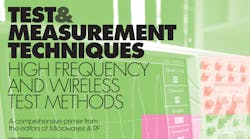Measurements can make or break a high-frequency design. When properly performed, they can be very revealing, uncovering both good and bad performance aspects of an electronic design. Of course, high-frequency measurements can also be very complex, and knowing which measurements to perform on which device under test (DUT) can be an adventure in itself.
Fortunately, Test & Measurement Techniques: High Frequency and Wireless Test Methods, edited by Microwaves & RF Contributing Editor Lou Frenzel, helps to take some of the guesswork out of which measurements are needed in different situations, and how to best perform those measurements. Written by Frenzel and other contributors, the e-book’s 10 chapters provide insights into key electronic performance parameters, including passive intermodulation (PIM), noise, jitter, intermodulation distortion, phase noise, and RF power.
Many of the chapters focus on measurements that are synonymous with the microwave industry, such as vector network analysis, and the high-performance instruments—vector network analyzers (VNAs)—that have been refined through the years by a number of different companies (including the e-book’s sponsor, Anritsu Co.) to keep pace with always-changing test requirements within the industry.
Measurement professionals may find the e-book somewhat tutorial in nature, since it attempts to cover a surprisingly broad range of measurements and test instruments for what is often considered such a “niche” portion of the electronics industry. But for those who may be knowledgeable about measurements for one particular type of DUT, such as insertion and return loss on RF/microwave filters, the e-book provides a refreshing introduction into measurements pertinent to DUTs at many levels—from active devices to radars and communications systems.
The e-book doesn’t just serve as a measurement primer for measurements related to analog RF components: It also provides basic guidance on measurements that can be applied to digital and photonics components, such as jitter measurements. The measurement advice is practical rather than theoretical, and includes instruction on how to adjust controls on the test equipment, how to read different types of test display screens, and even the basics of measuring different signal power levels throughout the microwave frequency range.
Frenzel and his contributors have compiled practical information on many measurements commonly used in the RF/microwave industry, while remaining unbiased about instrument manufacturers or even which type of instrument is “the only” choice for a measurement. For example, methods for power measurements are presented using spectrum analyzers as well as power meters, with full explanations of how they differ and why. This e-book is a handy reference to measurements that show the different sides of wireless and high-frequency products, and is well worth a download.

